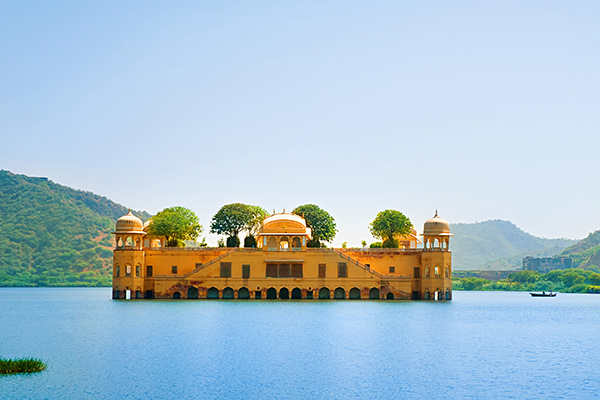Set in the middle of the picturesque Man Sagar Lake, Jal Mahal (Water Palace) in Jaipur is a spectacular structure that seems to be floating on the lake’s surface. An architectural marvel in itself, it is an embodiment of the engineering prowess of the Rajput period. The palace, which was built as a hunting lodge for the Maharajas of Jaipur, has now become one of the prime tourist attractions in the city. While planning your trip, don’t forget to book your hotels in Jaipur such that you have easy access to this magnificent palace and other forts and historical attractions in the city.
Want to know more about this splendid heritage structure? Here is everything about the Jal Mahal Palace in Jaipur, including its history, architecture, timings, entry fee, and other details.
Jal Mahal Information:
| Location | Amer Road |
| Type | Palace |
| Also Known as | The Water Palace |
| Timings | Morning till evening; every day |
| Entry Fee | Not open to visitors; can only be viewed from the lake shore |
| Still/Video Camera | Free |
| Architectural Style | Rajput and Mughal styles of architecture |
| Commissioned by | Maharaja Sawai Pratap Singh |
| Year of Construction | 18th century |
| Material Used | Red Sandstone |
Jal Mahal, Jaipur: History
Jal Mahal, one of the top places to visit in Jaipur, doesn’t have any recorded history about who built it or when. However, it is popularly believed that Maharaja Sawai Pratap Singh constructed Jal Mahal in 1799 to serve as a hunting lodge during his duck shooting trips. Some people also credit Maharaja Madho Singh I for the construction of this palace and date its origins back to the 1750s. Regardless of who built the palace, it was never meant to be used as a regular palace for living.
Later, the palace was renovated by Maharaja Jai Singh II of Amber in the 18th century. Over the years, the structure suffered subsidence due to partial seepage of lake water and waterlogging issues. After several years of deterioration and neglect, renovation works were carried out in the early part of the 21st century to restore the palace into its former glory. Though the palace and many of its features have been restored, its original terrace garden could not be salvaged. Plans are on to create a new terrace garden modeled on the rooftop garden of the famous Amer Palace in Jaipur.
Jal Mahal Architecture
Jal Mahal stands in the middle of a lake that has a maximum depth of 15 feet and a minimum depth of 4.9 feet. It is a five-storied structure built in the Rajput style of architecture, with influences of the Mughal architectural style. While four of its stories remain under water, only the top story remains visible, giving you an impression that the palace is floating on the waters of the lake.
Jal Mahal has been constructed out of red sandstone. Four elaborate chhatris designed in octagonal shape adorn the four corners of the palace. A huge Bengal-style rectangular chhatri also exists on the roof of the palace. In its heyday, the terrace garden of Jal Mahal was decorated with arched passages.
Jal Mahal, Jaipur: Today
Today, a visit to Jal Mahal counts among the top things to do in Jaipur. The alluring view of the palace against the backdrop of the verdant Aravalli Hills is a sight to cherish. No wonder, the Jal Mahal Palace in Jaipur is among the most photographed structures in India. It is also a paradise for bird watchers as various species of local and migratory birds flock to this lake.
As the palace remains submerged in a lake, a boat ride is the only way to reach it. The palace has been declared a protected property by the government, so boat rides and entry to the palace premises are restricted at present. However, you can spend hours admiring and photographing the palace from the lake shore. Every evening, the palace is illuminated for some time and the lit-up palace against the dark waters of the lake is indeed a sight to behold. The Jal Mahal Palace is located on the Amer Road, so you can combine it with your trip to the iconic Amer Fort.
Lesser Known Facts about Jal Mahal, Jaipur
- The fascinating terrace garden of the Jal Mahal is known as Chameli Bagh.
- Since the palace was constructed as a picnic spot rather than a residential structure, there are no personal chambers inside it.
- It is believed that the palace was constructed during a famine when the lake bed had completely dried up. So, the whole edifice was visible when it was built.
- The walls of this stone palace were so strongly built that it prevented any water from seeping in. Limestone mortar was used to reinforce the walls.
Attractions near Jal Mahal, Jaipur
- Kanak Vrindavan Mahal (1.4 km)
- Garh Ganesh Temple (3.7 km)
- Amer Palace (4 km)
- City Palace (4.4 km)
- Badrinath Temple (5.1 km)
- Anokhi Museum (5.2 km)
- Govind Dev Ji Temple (5.8 km)
- Albert Hall Museum (6 km)
- Jantar Mantar (6.1 km)
- Hawa Mahal (6.2 km)
- Jaigarh Fort (6.6 km)
- Bapu Bazar (6.7 km)
- Jaipur Zoo (7.4 km)
- Rambagh Palace (9 km)
- Birla Mandir (9.9 km)
It goes without saying that Jal Mahal is just one of the many splendid heritage structures in the Pink City. When you are visiting this palace, make sure to explore some of the other historical places in and around Jaipur. And above all, do not forget to taste the rich cuisine of the land at one of the best restaurants in Jaipur.
This post was last modified on 18-Aug-2023

